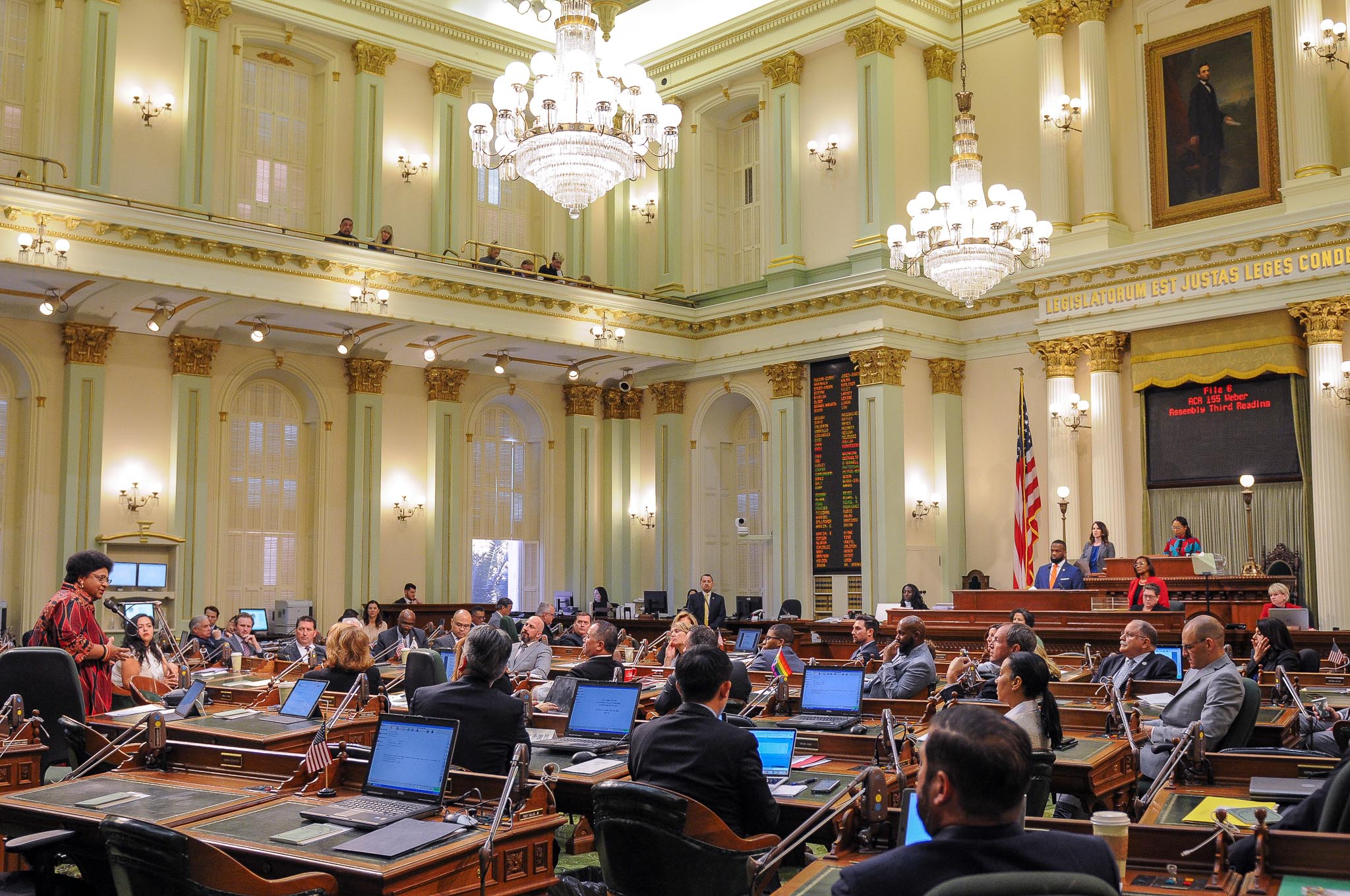
California State Capitol. (Photo: Kevin Sanders for California Globe)
General Provisions of California’s Evidence Code
Evidence Code applies in every action before the Supreme Court
By Chris Micheli, July 22, 2024 2:45 am
In Division 3 of the California Evidence, there are general provisions. Chapter 1 is on Applicability of the Code and contains Section 300. This section specifies that the Evidence Code applies in every action before the Supreme Court or a court of appeal or superior court, including proceedings in such actions conducted by a referee, court commissioner, or similar officer, but does not apply in grand jury proceedings.
Chapter 2 concerns Province of Court and Jury and contains Sections 310-312. Section 310 provides that all questions of law (including but not limited to questions concerning the construction of statutes and other writings, the admissibility of evidence, and other rules of evidence) are to be decided by the court. Determination of issues of fact preliminary to the admission of evidence are to be decided by the court.
Section 311 states, if the law of an organization of nations, a foreign nation or a state other than this state, or a public entity in a foreign nation or a state other than this state, is applicable and such law cannot be determined, the court may, as the ends of justice require, either apply the law of this state if the court can do so consistently with the Constitution of the United States and the Constitution of this state; or dismiss the action without prejudice or, in the case of a reviewing court, remand the case to the trial court with directions to dismiss the action without prejudice.
Section 312 specifies that, where the trial is by jury: (a) All questions of fact are to be decided by the jury. (b) Subject to the control of the court, the jury is to determine the effect and value of the evidence addressed to it, including the credibility of witnesses and hearsay declarants.
Chapter 3 is about Order of Proof and contains Section 320. This section specifies that the court in its discretion regulates the order of proof.
Chapter 4 deals with Admitting and Excluding Evidence. Article 1 provides general provisions. Section 350 states that no evidence is admissible except relevant evidence. Section 351 provides that, except as other provided, all relevant evidence is admissible.
Section 351.1 states that the results of a polygraph examination, the opinion of a polygraph examiner, or any reference to an offer to take, failure to take, or taking of a polygraph examination, shall not be admitted into evidence in any criminal proceeding, including pretrial and post conviction motions and hearings, or in any trial or hearing of a juvenile for a criminal offense, whether heard in juvenile or adult court, unless all parties stipulate to the admission of such results.
Section 351.2 provides that, in a civil action for personal injury or wrongful death, evidence of a person’s immigration status cannot be admitted into evidence, nor can discovery into a person’s immigration status be permitted.
Section 351.3 states that, in a civil action not governed by Section 351.2, evidence of a person’s immigration status cannot be disclosed in open court by a party or their attorney unless the judge presiding over the matter first determines that the evidence is admissible in an in camera hearing requested by the party seeking disclosure of the person’s immigration status. There are several exceptions.
Section 351.4 provides that, in a criminal action, evidence of a person’s immigration status cannot be disclosed in open court by a party or their attorney unless the judge presiding over the matter first determines that the evidence is admissible in an in camera hearing requested by the party seeking disclosure of the person’s immigration status.
Section 352 states that the court in its discretion may exclude evidence if its probative value is substantially outweighed by the probability that its admission will (a) necessitate undue consumption of time or (b) create substantial danger of undue prejudice, of confusing the issues, or of misleading the jury.
Section 352.1 provides that in a criminal proceeding in which the defendant is alleged to have compelled the participation of the victim by force, violence, duress, menace, or threat of great bodily harm, the district attorney may, upon written motion with notice to the defendant or the defendant’s attorney, if he or she is represented by an attorney, within a reasonable time prior to any hearing, move to exclude from evidence the current address and telephone number of any victim at the hearing.
Section 352.2 specifies that, in any criminal proceeding where a party seeks to admit as evidence a form of creative expression, the court, while balancing the probative value of that evidence against the substantial danger of undue prejudice is required to consider, in addition to the factors listed in Section 352, that: (1) the probative value of such expression for its literal truth or as a truthful narrative is minimal unless that expression is created near in time to the charged crime or crimes, bears a sufficient level of similarity to the charged crime or crimes, or includes factual detail not otherwise publicly available; and (2) undue prejudice includes, but is not limited to, the possibility that the trier of fact will treat the expression as evidence of the defendant’s propensity for violence or general criminal disposition as well as the possibility that the evidence will explicitly or implicitly inject racial bias into the proceedings.
Section 353 prohibits a verdict or finding from being set aside, nor can the judgment or decision based thereon be reversed, by reason of the erroneous admission of evidence unless:
There appears of record an objection to or a motion to exclude or to strike the evidence that was timely made and so stated as to make clear the specific ground of the objection or motion; and the court which passes upon the effect of the error or errors is of the opinion that the admitted evidence should have been excluded on the ground stated and that the error or errors complained of resulted in a miscarriage of justice.
Section 354 prohibits a verdict or finding from being set aside, nor can the judgment or decision based thereon be reversed, by reason of the erroneous exclusion of evidence unless the court which passes upon the effect of the error or errors is of the opinion that the error or errors complained of resulted in a miscarriage of justice.
Section 355 states that when evidence is admissible as to one party or for one purpose and is inadmissible as to another party or for another purpose, the court upon request must restrict the evidence to its proper scope and instruct the jury accordingly.
Section 356 provides that, where part of an act, declaration, conversation, or writing is given in evidence by one party, the whole on the same subject may be inquired into by an adverse party; when a letter is read, the answer may be given; and when a detached act, declaration, conversation, or writing is given in evidence, any other act, declaration, conversation, or writing which is necessary to make it understood may also be given in evidence.
Article 2 deals with Preliminary Determinations on Admissibility of Evidence. Section 400 defines the term “preliminary fact.” Section 401 defines the term “proffered evidence.” Section 402 provides that, when the existence of a preliminary fact is disputed, its existence or nonexistence shall be determined as provided in this article.
Section 403 states that the proponent of the proffered evidence has the burden of producing evidence as to the existence of the preliminary fact, and the proffered evidence is inadmissible unless the court finds that there is evidence sufficient to sustain a finding of the existence of the preliminary fact.
Section 404 provides that, whenever the proffered evidence is claimed to be privileged under Section 940, the person claiming the privilege has the burden of showing that the proffered evidence might tend to incriminate him; and the proffered evidence is inadmissible unless it clearly appears to the court that the proffered evidence cannot possibly have a tendency to incriminate the person claiming the privilege.
Section 405 specifies that, with respect to preliminary fact determinations not governed by Section 403 or 404: (a) When the existence of a preliminary fact is disputed, the court is required to indicate which party has the burden of producing evidence and the burden of proof on the issue as implied by the rule of law under which the question arises.
Section 406 states that this article does not limit the right of a party to introduce before the trier of fact evidence relevant to weight or credibility.
Chapter 5 concerns Weight of Evidence Generally. Section 410 defines the term “direct evidence.” Section 411 provides that the direct evidence of one witness who is entitled to full credit is sufficient for proof of any fact. Section 412 provides that, if weaker and less satisfactory evidence is offered when it was within the power of the party to produce stronger and more satisfactory evidence, the evidence offered should be viewed with distrust.
Section 413 provides that, in determining what inferences to draw from the evidence or facts in the case against a party, the trier of fact may consider, among other things, the party’s failure to explain or to deny by his testimony such evidence or facts in the case against him, or his willful suppression of evidence relating thereto, if such be the case.
- Third-party Claims - January 6, 2026
- New Trials in California - January 5, 2026
- Property of Unincorporated Associations - January 5, 2026




